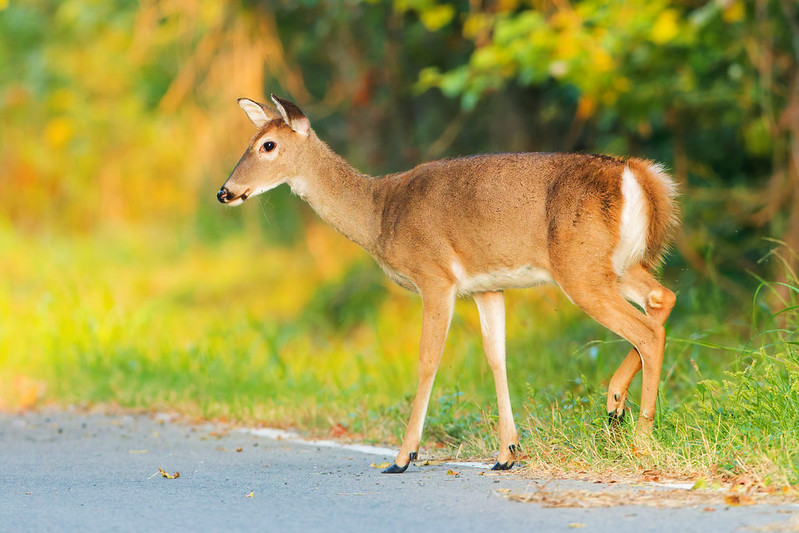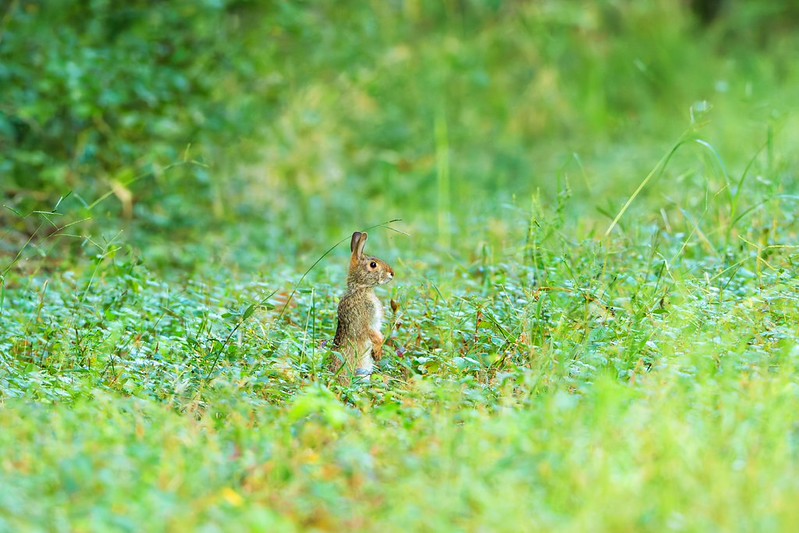I was driving the auto tour road at Oklahoma’s Sequoyah National Wildlife Refuge when I noticed two whitetail does grazing by the roadside. I pulled over and photographed one of the does from inside my truck.
Just as I steadied my camera, she froze. Her ears turned forward and her eyes locked on something across the road. I followed her gaze and saw a small rabbit standing upright in the grass, staring back at her.

The rabbit did not flinch. It balanced on its hind legs, watching the deer with surprising calm. The doe seemed puzzled at first, then relaxed and lowered her head to graze again. For a brief moment, they shared the same quiet space, two very different animals showing a kind of mutual awareness.

Moments like this are what I love most about wildlife photography. It is not only about sharp images or perfect light but about watching these small, spontaneous exchanges that happen when animals simply coexist. As the does returned to feeding, the rabbit slipped back into the tall grass, leaving me with a smile and a few memorable frames.
Wildlife Notes
White-tailed Deer (Odocoileus virginianus): These does showed typical vigilant grazing behavior, feeding, then pausing to scan for danger. Whitetails rely on sharp hearing, and their large ears rotate independently to pinpoint sounds. This doe’s quick alert response to the rabbit shows how sensitive they are to even harmless movement. In fall, does often travel in small family groups of related females and fawns. Staying together helps them detect predators early and forage safely.
Cottontail Rabbit (likely Eastern Cottontail, Sylvilagus floridanus): The rabbit’s upright stance is called a sentinel posture. It lets the animal watch for predators while staying partly hidden. Cottontails are crepuscular, active in the same dawn and dusk hours when deer feed. They share many of the same plants, including grasses and clover, which explains why they often appear in the same areas.
Interspecies Interactions: What I witnessed is known as neutral coexistence between herbivores. Both deer and rabbits benefit from associative vigilance, where more eyes and ears help spot danger. Their alertness followed by calm shows how animals interpret each other’s body language to gauge safety.
Photography Notes
Vehicle as a Blind: Photographing from my truck helped me stay unnoticed. Deer often tolerate vehicles far better than people on foot. The truck served as a mobile blind, hiding my scent and shape.
Lens and Settings:
Camera: Canon EOS R7
Lens: Canon EF 500mm f/4L IS USM
Aperture: f/5.6
Shutter Speed: 1/800 sec
ISO: 5000 (Auto)
Exposure Comp: 0
At 500mm on the R7’s crop sensor, I had the reach of almost 800mm. That was perfect for tight framing without disturbing the animals. I chose f/5.6 for a bit more depth of field than f/4, keeping the doe’s face and body sharp while softening the background.
Light and Timing: The early morning light was soft and even, ideal for subtle tones in the deer’s fur. High ISO handled the low light well. I prefer a slightly grainy sharp image over a clean but blurry one.
Anticipation: The key to the shot was reading the doe’s body language. Her ears flicked before she locked onto the rabbit, and that tiny cue let me react in time. Observing the whole scene, not just through the viewfinder, often makes the difference between missing and capturing a special moment.
